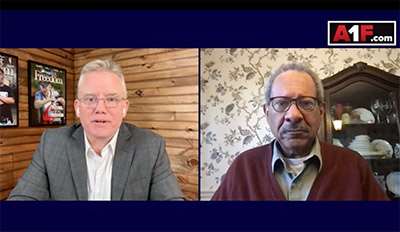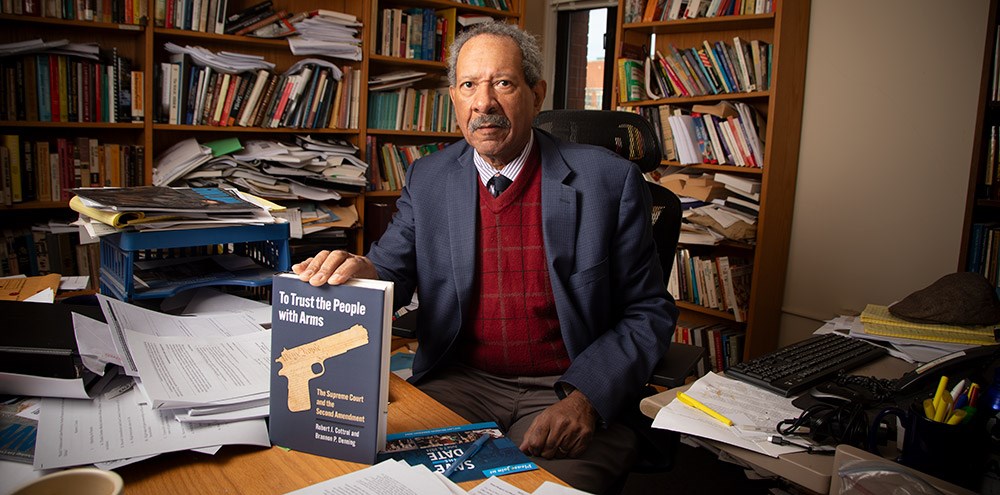
Robert J. Cottrol, a professor of law and history with George Washington University and the author of To Trust the People with Arms, concluded that a lot of Americans need to better understand the Second Amendment of the U.S. Bill of Rights. As teaching is what he does, he decided to put the Second Amendment’s legal story between the covers of a book. If this endeavor sounds legalistic or even lofty, perhaps that is a good thing, as an honestly researched and written case history of the right to keep and bear arms is certainly an operative way to expose the one-sided spin and deceits of the gun-control politics that has become the dogma of today’s mainstream media.
A1F: You wrote this book during a very interesting time, as you finished your book just after the NRA-backed Second Amendment case New York State Rifle & Pistol Association v. Bruen (2022) was decided.
Cottrol: Yes, indeed. It’s rare for a historian to have a stop-the-presses moment. Basically, we had this with Bruen. We had written a book that basically takes us from the founding to Heller (2008) and McDonald (2010), but then we saw Bruen coming and we thought, My goodness, we can’t omit Bruen. This is incredible. They’re talking about the right to carry outside the home.
A1F: As you were raised in New York City, how were you exposed to our Second Amendment rights?
Cottrol: Most people who are somewhat strong supporters of the Second Amendment will tell you they grew up in families with guns and they went hunting and so forth. None of that applies to me. I grew up in New York City. My family didn’t have guns. I became interested in the Second Amendment at roughly the age of 12 after three things hit me.
First, I saw the 1959 movie The Diary of Anne Frank. Shelley Winters was in it with other stars of that era. I also happened to see an essay that asked what if Otto Frank, Anne Frank’s father, had a gun? Much later in life, I visited Amsterdam and went to the Anne Frank house. And one of the things that’s interesting, is to get to the attic where they were staying, you have to climb a very steep and narrow staircase. Basically, it’s not a place that can be rushed by several people at the same time. That only accelerated the thought that what if they had been armed and managed to get away that night?
The second thing that I read was a 1962 book by Robert Williams titled Negroes with Guns. Williams was an NAACP organizer in North Carolina in the 1950s. He was working on voter registration and the Klan sent threats to him. He turned his NAACP chapter into an NRA gun club, and thus was able to get some of the surplus World War II guns. The bottom line was that when the Klan saw his NAACP chapter was armed, they didn’t want any part of them.
The third was The Boy Scouts Handbook. It had a section on the U.S. Bill of Rights and talked about the Second Amendment. It explained it as sort of a hedge against tyranny.

A1F: So, you came to understand this freedom intellectually, not because you were physically introduced to shooting. Fascinating. When did you first shoot?
Cottrol: I joined the Army National Guard right after college. I trained in marksmanship. And then, as a graduate student, I took up shooting as a sport. I’ve been a shooter ever since.
A1F: As there are a lot of Second Amendment books out there, why do you think this book is necessary now?
Cottrol: Well, I think that many have gotten a distorted picture of the Second Amendment; largely, I would say, this is from the gun-control movement and the press. So, I decided, with Brannon Denning, to do a book that would look at the history and the law regarding the Second Amendment and what the courts had said about it and other matters that were pertinent. So, we looked at the actual cases that occurred before Heller, as well as the history of the adoption of the Second Amendment, and, I would add, the 14th Amendment; as we did, it became very clear that the people who drafted and ratified those amendments were thinking of the right to bear arms as a right of individuals. We wrote about this in part to set the record straight, but, also, because it’s a fascinating story.
A1F: So then, as a law and history professor, are you surprised that the Supreme Court only got to the basis of the Second Amendment in the 21st century?
Cottrol: Not really, because if you look at the history, you see that the Supreme Court didn’t start incorporating rights until the early 20th century—incorporation, of course, means applying the U.S. Bill of Rights to state and local governments. The framers of the 14th Amendment, which was enacted in 1868, had two aims in mind. One was to establish the principle of racial equality as a matter of constitutional law, that government cannot treat people of different races differently or unequally. The second objective was to have the states protect these fundamental rights, particularly the rights found in the Bill of Rights. In McDonald, in 2010, the Supreme Court incorporated the Second Amendment.
A1F: So, you’re living right in history, as these three decisions from the high court have put us into a pivotal constitutional period.
Cottrol: Exactly. Basically, what we’re seeing right now is a massive resistance in some jurisdictions to the facts; this is similar to the massive resistance we had in the 1950s to school integration. The Supreme Court made decisions and then all sorts of local officials basically began thumbing their noses, saying they’re not going to obey.
A1F: Right, in Bruen, Justice Clarence Thomas said that sensitive-place restrictions can’t just apply, for example, to the entire island of Manhattan; yet, New York has broadened such restrictions to basically the entire state.
Cottrol: A number of jurisdictions—and New York is perhaps the worst offender—lived for better than a century as if the Second Amendment simply didn’t exist; therefore, they could enact any measure they wanted. And so, these decisions have come as a real shock to them.
A1F: How are you being received with a book like this in academia?
Cottrol: I think the extent to which academia is populated solely by the far Left has been overstated. What’s amazing is, if you look at the academics in the 1990s who said, wait, this really is an individual right, you’ll find that perhaps a majority of them were, in fact, liberals. I’ll give you a famous example: Laurence Tribe of Harvard, who is one of the foremost liberal constitutional scholars, revised his treatise on constitutional law. Previously, he had said it’s a right of the militia and not a right of the individual; in his latest edition, he said he read the scholarship and is now convinced it is an individual right.
A1F: One thing I also found well-substantiated in To Trust the People with Arms is that gun control has often been used to disenfranchise minority groups.
Cottrol: Oh yes, I thoroughly agree. I mean, look at the effort that was made basically to ban guns in public housing. It is unconscionable. You’re taking people who are not well protected by society and telling them they can’t have the means to protect themselves. There’s nothing liberal about that. And yet, somehow, liberal groups and newspapers applaud those efforts.
A1F: Are you hopeful that your students are getting an understanding of our individual rights?
Cottrol: Well, for most of American history, people and the courts generally recognized that the right to bear arms is an individual right.
In contrast, the modern gun-control movement has always had a strong prohibitionist element in it. The gun-control movement worked hard to sell the idea that the Second Amendment, despite its language, did not protect a right of the people at all, but instead it protected some sort of largely undefined right of militias or states. The American public didn’t buy this attempted re-definition.
Still, a lot of people grew up and became lawyers in that atmosphere.
Today, they’re growing up in a somewhat different atmosphere. The Supreme Court now says it is an individual right. Everybody who now goes to law school reads the new case books and, so, has to deal with Heller, McDonald and Bruen. So, in a sense, there’s a normalization taking place with regards to this individual right.


































